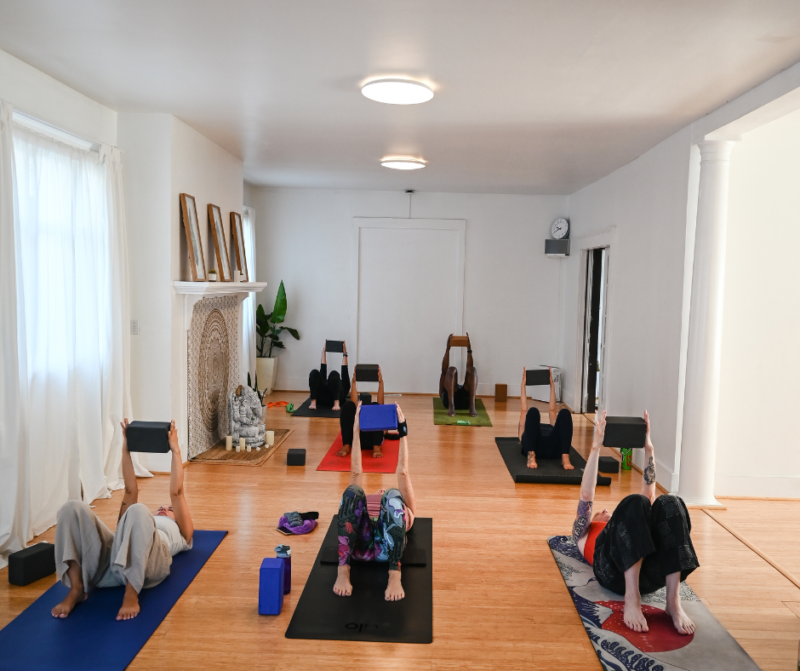Confused about what class is the right class for you? What are the most popular styles of Yoga that are practiced in the West? What are some popular misconceptions about those popular styles of Yoga? Get your answers here!
First and foremost, any physical yoga that is practiced in the west falls under the general description of Hatha Yoga. The word hatha means willful or forceful. The word hatha refers to a set of physical exercises (known as asanas or postures), sequenced and designed to align your skin, muscles, and bones. The postures are also designed to open the flow of energy throughout the body.
The History of Yoga is deep and vast and somewhat complicated. How we practice Yoga now in the west is very different than how it was practiced thousands of years ago. Traditionally, the physical practice of yoga was a series of about 12 postures that were all done seated with the purpose of preparing the body for meditation. This practice was born out of the Yoga Sutras of Patanjali which describes yoga as union. In his work, Patanjali describes hatha yoga as consisting of eight limbs, or disciplines, that he he referred to as the 8 limb path. The Sutras are like a handbook to happiness or the method in achieving enlightenment, with the physical practice being only one of those 8 limbs.
Once Hatha yoga started to grow and expand, it became a deeper physical practice that incorporated more “fitness”. The most well known styles of modern yoga came from the schools of Krishnamacharya, who taught in India from 1924 until his death in 1989. Today’s modern styles, including Ashtanga, Iyengar, yin, power, vinyasa, restorative, Jivamukti, and Bikram have been influenced from this as well as other lineages . If you see a “Hatha” class on a studio’s schedule, you should really ask the studio what type of class it is, because of the general use of the term to refer to a broad range of styles. In most modern western Yoga classes regardless of the style, breath work, meditation and postures are three main limbs that are typically practiced in a class, with postures often being the primary focus.
So what are the main styles of Yoga you will see on a studio’s class schedule? Yoga can range from relaxing to down right sweaty and tough so getting into the right class for your fitness level will often determine if you stick with the practice long enough to experience its profound benefits. Here is a list of common yoga classes that you will see on a typical studio’s schedule, unless the studio specializes in a specific lineage.
Hatha
Hatha yoga is now a generic term that refers to any type of yoga that teaches physical postures. As stated earlier, nearly every type of yoga class taught in the West is hatha yoga. When a class is marketed as hatha, it generally means that you will get a gentle introduction to the most basic yoga postures. You will work on strength and flexibility, but likely wont work up a big sweat.
Ashtanga
Ashtanga was popularized and brought to the West by Pattabhi Jois (pronounced “pah-tah-bee joyce”) in the 1970s. It’s a rigorous style of yoga that follows a specific sequence of postures and is sometimes described as the parent of vinyasa yoga, because each style links every movement to a breath. The difference is that ashtanga always performs the exact same poses in the exact same order. This is a physically demanding practice that challenges the practitioner’s body and mind!
Bikram
In a Bikram class, you will work your way through a series of 26 poses (although different from the Ashtanga sequence, a Bikram class always follows the same sequence) On a class schedule if you see “Hot Yoga” its most likely a Bikram class. Generally, the only difference between Bikram and a general hot yoga class is that the class may deviate from the set sequence. The room will usually be heated well over 100 degrees.
Iyengar
Iyengar yoga was developed and popularized by B.K.S. Iyengar (pronounced “eye-yen-gar”). Iyengar is a very meticulous style of yoga, with utmost attention paid to finding the proper alignment in a pose. The use of props like blocks, blankets, straps, chairs, bolsters, and a rope wall are all common in an Iyengar class. Postures are typically held for longer which can be physically demanding, but you won’t move around alot so you won’t have a ton of cardiovascular work.
Vinyasa
Likely the most practiced style in the United States, Vinyasa (pronounced “vin-yah-sah”) means to place in a special way, and vinyasa classes are known for their fluid, movement-intensive practices. Vinyasa teachers choreograph their classes to smoothly transition from pose to pose, and often play music to keep things lively. The intensity of the practice can vary because no two vinyasa classes are the same. A “power vinyasa” class can be very physically challenging both in strength and cardiovascular. You can also get a vinyasa class that is a more gentle flow. You will still move breath to movement, but may go at a slower pace. Vinyasa classes typically focus on heating the body with Sun Salutations. If you love variety, vinyasa may be the practice for you! Check with your studio on the different types of Vinyasa classes they offer (most have “levels of difficulty”) so you can ensure you get into the right class for you!
Restorative
Restorative yoga is a great way to way to relax the body, mind and soul. Restorative classes use bolsters, blankets, and blocks to prop students in passive poses so that the body can experience the benefits of a pose without having to exert any effort. A good restorative class will leave you feel rejuvenated.
Yin
Yin Yoga is often confused with restorative yoga, but the two are very different! Yin Yoga is a series of floor postures held for 1-5 minutes each. Yin Yoga targets the connective tissues, such as the ligaments, bones, and even the joints of the body that normally are not exercised very much in a more active style of asana practice.
Suitable for almost all levels of students, Yin Yoga is a perfect complement to the dynamic heat building style of yoga.
Yoga Nidra
Yoga Nidra is yogic sleep. It is a five-stage process that incorporates meditation on the breath, the balancing of energy, visualization, and self-healing. You are in a deep state of relaxation in between wake and sleep. Setting a positive intention, called sankalpa is another important step which gives the participant a specific focus for the class.
Kundalini
Kundalini yoga features constantly moving, invigorating poses, dynamic breath and meditation. The fluidity of the practice is intended to release the kundalini energy located like a coiled serpent in the base of your spine. The energy then moves upward invigorating all areas of you body! Kundalini is accompanied many mantras and kriyas designed uplift and energize.
What ever style of yoga you choose, the benefits of yoga are profound with continued practice. The goal of “union” truly makes this practice very different than a typical “work out”. If you goals are physical, mental, spiritual or all of the above, this practice will have something for you!





